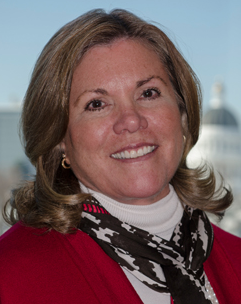Employers, Carriers Could Bear Cost of Newsom's COVID-19 Order, but Questions Remain
Friday, May 8, 2020 | 6
As California begins its phase-by-phase reopening process Friday, Gov. Gavin Newsom’s executive order creating a rebuttable COVID-19 presumption has cast a shadow of uncertainty for insurance carriers and employers.

Jill Dulich
(CSIA photo)
“I’ve gotten a few phone calls. Clients have said, ‘Are you kidding me?’” said attorney Nicholas Roxborough, of Woodland Hills firm Roxborough, Pomerance, Nye & Adreani. “They’re getting hit every which way with the coronavirus, they’ve had to lay people off, and now they’re getting hit by this order. I haven’t had one good phone call about it all day.”
Newsom’s long-awaited executive order creates a rebuttable presumption stating that all employees who contract COVID-19 at their place of work while at the direction of an employer are eligible for workers’ compensation benefits. The order is retroactive to March 19 — the first day of Newsom’s stay-at-home order — and runs through July 5.
The order applies to all workers’ compensation insurance carriers, self-insured employers and employers otherwise carrying their own risk, including the state itself.
Self-insurers and employers with large deductibles will be hit hardest by an influx of COVID-19 claims because they may have to pay hundreds of thousands of dollars out of pocket for expensive medical treatment, Roxborough said.
“And, as far as carriers go, more likely than not your premiums will go up because there’s a cost they didn't anticipate,” he said.
Jill Dulich, executive director for the California Self-Insurers Association, said her organization is still trying to figure out how to respond to Newsom’s order.
“Self-insurers in California are already doing all that they can to assist their employees in this time of crisis through various means such as extra sick leave, medical monitoring and a number of other benefits,” Dulich said in a statement. “Given that the EO is new to the entire workers’ compensation community, we do not yet know what the impact on self-insurers will be. While the self-insured community is still working out the details and how they will manage all aspects of the executive order, their main goal is compliance with the governor’s order.”
Phase two of Newsom’s plan to ease the state out of his stay-at-home order begins Friday, with some cities and counties being allowed to inch ahead in the process by opening businesses beyond those mentioned in the state’s policy.
Music stores, toy stores, bookstores, clothing stores, sporting goods stores and florists will be able to reopen for curbside pickup. Factories that manufacture products for approved businesses will also be allowed to reopen.
And while the state’s reopening could add a needed reprieve for businesses, employers across the state are still searching for answers on how to adjust to the executive order, said Leslie Tuxhorn, a Los Angeles insurance attorney with the Hanna Brophy firm.
“Everyone in California has questions about the executive order now,” Tuxhorn said in a webinar Thursday that featured claimants' and defense lawyers.
The order creates a rebuttable presumption, but that means the employer must prove that the COVID-19-sickened worker did not contract the virus through the course and scope of employment.
“And it's very difficult to prove a negative,” Tuxhorn said.
Defense firms are studying ways to attack the order and to see if state laws may affect how it is enforced. Tuxhorn noted that Newsom's recent executive order to close beaches has been challenged in court by Newport Beach officials as unconstitutional, and that may provide guidance on the presumption order.
“I think he has the best interests of the state at heart, but his track record is not perfect,” Tuxhorn said. “There could be ways to attack the order. We just don't know for sure at this point.”
David A. Sampson, president and CEO of the American Property Casualty Insurance Association, said in a statement Wednesday that Newsom’s order could destabilize the state’s workers’ compensation system.
“APCIA believes this overly broad executive order jeopardizes the stability of the workers' compensation system. Maintaining proof of a causal connection that a covered injury or disease was contracted in the workplace is essential for a stable no-fault workers' compensation system for employers and employees alike,” Sampson said. “It is important to remember that under current law, workers who contract COVID-19 in the course of their employment are already able to file claims and receive benefits. Our members insure the majority of California employers and are firmly committed to delivering timely workers' compensation benefits and protections during this extraordinary time.”
Michael C. Duff, a University of Wyoming law professor with expertise in workers’ compensation, called Newsom’s order “a whirlwind” but said it was too early to tell how it would impact California’s workers’ compensation system.
“It is very difficult to speculate as to the ultimate impact of the order on self-insured employers or commercial carriers,” Duff said. “And, of course, there are always two sides to cost: the cost to employer and insurance interests adversely impacted by the presumption, and the costs to workers in the absence of a presumption. Costs never go away, they shift."
One possible advantage of the 60-day executive order is that it could provide the state more flexibility than it would have if the presumption were enacted through statute, Duff said.
There are currently two bills before state lawmakers that would create conclusive presumptions for specified workers who contract COVID-19, and two bills that would create rebuttable presumptions.
Duff said the governor can allow his order to expire if costs are skyrocketing after 60 days.
"If, on the other hand, burdens are manageable, the state has valuable information about options it might pursue should COVID-19 impacts continue or even intensify," he said. "A legislative approach could potentially be less nimble.”






Comments